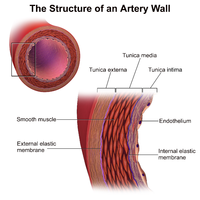
Photo from wikipedia
February 5, 2019 727 James E. Udelson, MD The most feared complication of hypertrophic cardiomyopathy (HCM) is sudden cardiac death (SCD). Because the risk of SCD is higher in younger… Click to show full abstract
February 5, 2019 727 James E. Udelson, MD The most feared complication of hypertrophic cardiomyopathy (HCM) is sudden cardiac death (SCD). Because the risk of SCD is higher in younger patients with HCM, SCD is particularly devastating, robbing decades of life. The lifesaving impact of implantable cardioverter-defibrillators (ICDs) has made assessing sudden death risk in patients with HCM an imperative.1 The incidence of SCD in patients with HCM is low, such that any risk stratification approach is plagued by a low positive predictive value. As in patients with heart failure, we accept that a good percentage of implanted ICDs may never deliver an intervention, the price to pay for saving young lives. How to balance the imperative to save as many lives as possible while minimizing “unnecessary” ICD implantations is a vexing challenge. The assessment of SCD risk and primary prevention in HCM over recent years has diverged between the American and European society recommendations. In the 2011 American College of Cardiology Foundation (ACCF)/American Heart Association (AHA) guideline for the diagnosis and treatment of HCM,1 a Class IIa recommendation (ICD is reasonable) was made for those with any one of the following: a family history of SCD, unexplained syncope, or maximal wall thickness ≥30 mm. The usefulness was said to be uncertain (Class IIB) in those with only nonsustained ventricular tachycardia or an abnormal exercise blood pressure response, although reasonable (Class IIA) if those occurred in the presence of other modifiers such as late gadolinium enhancement on cardiac magnetic resonance imaging, marked outflow tract obstruction, double or compound mutations, or an apical aneurysm. Those individual factors were based on a distillation of the literature on SCD risk to that point in time. In fact, the approach is somewhat simplistic. The studies on which the recommendations are based span many years and involved different definitions of the factors of interest and SCD. Many of the cited studies are of modest population size, so the absolute number of SCD events was quite modest within the individual reports (often <30 SCD events), making multivariable analysis results unstable. The dichotomization of the factors (<30-mm versus ≥30-mm wall thickness, for instance) results in loss of information (eg, a patient with 45-mm wall thickness is likely at greater SCD risk than a patient with 31-mm thickness, and the SCD risk of 2 patients with 29-mm versus 31-mm wall thickness is likely little different). Despite its simplicity, application of this approach to inform ICD recommendations has resulted in a very low disease-related death rate in contemporary patients with HCM. The 2014 European Society of Cardiology (ESC) guidelines on the diagnosis and management of HCM3 take a different approach, recommending risk stratification with the HCM Risk-SCD tool to stratify 5-year SCD risk. Some of the factors in the model are the same as in the ACCF/AHA approach (wall thickness, family history © 2019 American Heart Association, Inc. ON MY MIND
Journal Title: Circulation
Year Published: 2019
Link to full text (if available)
Share on Social Media: Sign Up to like & get
recommendations!